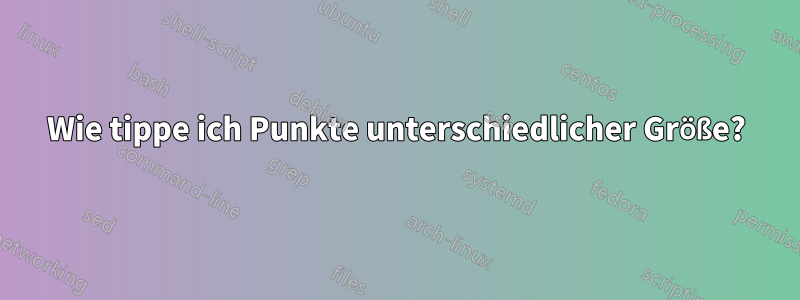
Antwort1
Im Standard-Mathematikmodus können Sie \circfür einen kleinen weißen Punkt und \bulletfür einen kleinen schwarzen Punkt verwenden. Mit dem Paket wasysymkönnen Sie Circleund CIRCLEBefehle für die großen Punkte verwenden.
 Beachten Sie, dassenttextenist ein großartiges Tool zum Suchen von Symbolen. Es gibt auch viele Listen mit LaTeX-Symbolen, wieDieses hier.
Beachten Sie, dassenttextenist ein großartiges Tool zum Suchen von Symbolen. Es gibt auch viele Listen mit LaTeX-Symbolen, wieDieses hier.
Antwort2
Hier ist mein Beispiel:
\documentclass[12pt]{report}
\usepackage{tikz}
\begin{document}
$\circ $
$\bullet$
$\bigcirc$
Some Text \tikz\draw[black,fill=black] (0,0) circle (1ex); more text
\end{document}
Überprüfen Sie auch:Wie zeichnet man einen einfarbigen Kreis?und für ams-math-Dokumente:http://ftp.acc.umu.se/mirror/CTAN/info/short-math-guide/short-math-guide.pdf.
Antwort3
Sie können einige Glyphen verwenden, mathabxohne das Paket zu laden:
\documentclass{article}
\usepackage{geometry}
\DeclareFontFamily{U}{mathb}{\hyphenchar\font45}
\DeclareFontShape{U}{mathb}{m}{n}{ <-6> mathb5 <6-7> mathb6 <7-8>
mathb7 <8-9> mathb8 <9-10> mathb9 <10-12> mathb10 <12-> mathb12 }{}
\DeclareSymbolFont{mathb}{U}{mathb}{m}{n}
%
\DeclareFontFamily{U}{mathx}{\hyphenchar\font45}
\DeclareFontShape{U}{mathx}{m}{n}{ <-6> mathx5 <6-7> mathx6 <7-8>
mathx7 <8-9> mathx8 <9-10> mathx9 <10-12> mathx10 <12-> mathx12 }{}
\DeclareSymbolFont{mathx}{U}{mathx}{m}{n}
\DeclareMathSymbol{\newmoon} {\mathord}{mathb}{"4D}%swapped in the original file
\DeclareMathSymbol{\fullmoon} {\mathord}{mathb}{"4E}%swapped in the original file
\DeclareMathSymbol{\bigovoid} {\mathop}{mathx}{"EC}
\newcommand{\Circ}{$\vcenter{\hbox{$\newmoon\;$}}$}
\newcommand{\CIRC}{${\bigovoid}\;$}
\newcommand{\thickdot}{$\vcenter{\hbox{$\fullmoon\;$}}$}
\newcommand{\DOT}{$\vcenter{\hbox{\Large$\fullmoon\:$}}$}
\begin{document}
\fbox{\parbox{0.9\linewidth}{Here the vertices are indicated according to their heights, where \DOT denotes a vertex of height $3$, \thickdot denotes height $2$, \Circ denotes height $1$ and \CIRC denotes height $0$. }}
\end{document}





